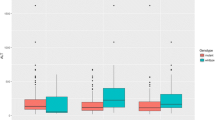Abstract
Hepatitis B virus (HBV) infection is one of the major causes of chronic liver inflammation. Toll-like receptor 3 (TLR3) plays a key role in innate immunity and is responsible for recognizing viral pathogens. It has been reported that the TLR3 C1234T polymorphism is associated with various diseases. The aim of this study was to investigate whether TLR3 polymorphisms were correlated with susceptibility to chronic HBV infection. Two polymorphisms in the TLR3 gene, A952T and C1234T, were tested by direct sequencing in 452 chronic hepatitis B (CHB) patients and 462 healthy controls. Data showed that subjects carrying 1234CT genotype and TT genotype had 1.42-fold and 2.31-fold increased risk of chronic HBV infection compared to those with CC genotype (95 % confidence interval [CI] = 1.08–1.86, p = 0.012; 95 % CI = 1.34–3.96, p = 0.002, respectively). Further analysis revealed that the prevalence of 1234CT genotype and T allele was significantly increased in CHB patients with acute-on-chronic liver failure (ACLF) than those without ACLF (odds ratio [OR] = 1.55, p = 0.030; OR = 1.43, p = 0.040, respectively). These results indicate that TLR3 C1234T polymorphism could be a risk factor for the development of chronic HBV infection, especially the CHB-related ACLF.
Similar content being viewed by others
References
Tan, Y.J. 2011. Hepatitis B virus infection and the risk of hepatocellular carcinoma. World Journal of Gastroenterology 17: 4853–4857.
Gish, R., J.D. Jia, S. Locarnini, and F. Zoulim. 2012. Selection of chronic hepatitis B therapy with high barrier to resistance. The Lancet Infectious Diseases 12: 341–353.
Olson, J.C., and P.S. Kamath. 2012. Acute-on-chronic liver failure: What are the implications? Current Gastroenterology Reports 14: 63–66.
Lee, C.C., A.M. Avalos, and H.L. Ploegh. 2012. Accessory molecules for Toll-like receptors and their function. Nature Reviews Immunology 12: 168–179.
Horscroft, N.J., D.C. Pryde, and H. Bright. 2012. Antiviral applications of Toll-like receptor agonists. The Journal of Antimicrobial Chemotherapy 67: 789–7801.
Hornung, V., S. Rothenfusser, S. Britsch, A. Krug, B. Jahrsdorfer, T. Giese, et al. 2002. Quantitative expression of Toll-like receptor 1–10 mRNA in cellular subsets of human peripheral blood mononuclear cells and sensitivity to CpG oligodeoxynucleotides. Journal of Immunology 168: 4531–4537.
Schwarz, K., T. Storni, V. Manolova, A. Didierlaurent, J.C. Sirard, P. Rothlisberger, et al. 2003. Role of Toll-like receptors in costimulating cytotoxic T cell responses. European Journal of Immunology 33: 1465–1470.
Kaisho, T., and S. Akira. 2003. Regulation of dendritic cell function through Toll-like receptors. Current Molecular Medicine 3: 373–385.
Bsibsi, M., R. Ravid, D. Gveric, and J.M. van Noort. 2002. Broad expression of Toll-like receptors in the human central nervous system. Journal of Neuropathology and Experimental Neurology 61: 1013–1021.
Zhou, Y., X. Wang, M. Liu, Q. Hu, L. Song, L. Ye, D. Zhou, and W. Ho. 2010. A critical function of toll-like receptor-3 in the induction of anti-human immunodeficiency virus activities in macrophages. Immunology 131: 40–49.
Li, N., Q. Li, Z. Qian, Y. Zhang, M. Chen, and G. Shi. 2009. Impaired TLR3/IFN-beta signaling in monocyte-derived dendritic cells from patients with acute-on-chronic hepatitis B liver failure: Relevance to the severity of liver damage. Biochemical and Biophysical Research Communications 390: 630–635.
Ueta, M., C. Sotozono, T. Inatomi, K. Kojima, K. Tashiro, et al. 2007. Toll-like receptor 3 gene polymorphisms in Japanese patients with Stevens–Johnson syndrome. The British Journal of Ophthalmology 91: 962–965.
Sironi, M., M. Biasin, R. Cagliani, D. Forni, M. De Luca, I. Saulle, et al. 2012. A common polymorphism in TLR3 confers natural resistance to HIV-1 infection. Journal of Immunology 188: 818–823.
Mandal, R.K., G.P. George, and R.D. Mittal. 2012. Association of Toll-like receptor (TLR) 2, 3 and 9 genes polymorphism with prostate cancer risk in North Indian population. Molecular Biology Reports 39: 7263–7269.
Dai, J., Z. Hu, J. Dong, L. Xu, S. Pan, Y. Jiang, et al. 2012. Host immune gene polymorphisms were associated with the prognosis of non-small-cell lung cancer in Chinese. International Journal of Cancer 130: 671–676.
Breckpot, K., D. Escors, F. Arce, L. Lopes, K. Karwacz, et al. 2010. HIV-1 lentiviral vector immunogenicity is mediated by Toll-like receptor 3 (TLR3) and TLR7. Journal of Virology 84: 5627–5636.
Daffis, S., M.A. Samuel, M.S. Suthar, M. Gale Jr., and M.S. Diamond. 2008. Toll-like receptor 3 has a protective role against West Nile virus infection. Journal of Virology 82: 10349–10358.
Klein Klouwenberg, P., L. Tan, W. Werkman, G.M. van Bleek, and F. Coenjaerts. 2009. The role of Toll-like receptors in regulating the immune response against respiratory syncytial virus. Critical Reviews in Immunology 29: 531–550.
Li, K., N.L. Li, D. Wei, S.R. Pfeffer, M. Fan, and L.M. Pfeffer. 2012. Activation of chemokine and inflammatory cytokine response in hepatitis C virus-infected hepatocytes depends on Toll-like receptor 3 sensing of hepatitis C virus double-stranded RNA intermediates. Hepatology 55: 666–6675.
Wu, J., M. Lu, Z. Meng, M. Trippler, R. Broering, A. Szczeponek, et al. 2007. Toll-like receptor-mediated control of HBV replication by nonparenchymal liver cells in mice. Hepatology 46: 1769–1778.
Wang, K., H. Liu, Y. He, T. Chen, Y. Yang, et al. 2010. Correlation of TLR1-10 expression in peripheral blood mononuclear cells with chronic hepatitis B and chronic hepatitis B-related liver failure. Human Immunology 71: 950–956.
Ranjith-Kumar, C.T., W. Miller, J. Sun, J. Xiong, J. Santos, I. Yarbrough, et al. 2007. Effects of single nucleotide polymorphisms on Toll-like receptor 3 activity and expression in cultured cells. The Journal of Biological Chemistry 282: 17696–17705.
Acknowledgments
This study was supported by the 12th Five-Year National Science and Technology Major Project for Infectious Diseases (no. 2012ZX10002004-005).
Conflict of Interest
No competing financial interests exist.
Author information
Authors and Affiliations
Corresponding author
Rights and permissions
About this article
Cite this article
Rong, Y., Song, H., You, S. et al. Association of Toll-like Receptor 3 Polymorphisms with Chronic Hepatitis B and Hepatitis B-Related Acute-on-Chronic Liver Failure. Inflammation 36, 413–418 (2013). https://doi.org/10.1007/s10753-012-9560-4
Published:
Issue Date:
DOI: https://doi.org/10.1007/s10753-012-9560-4




